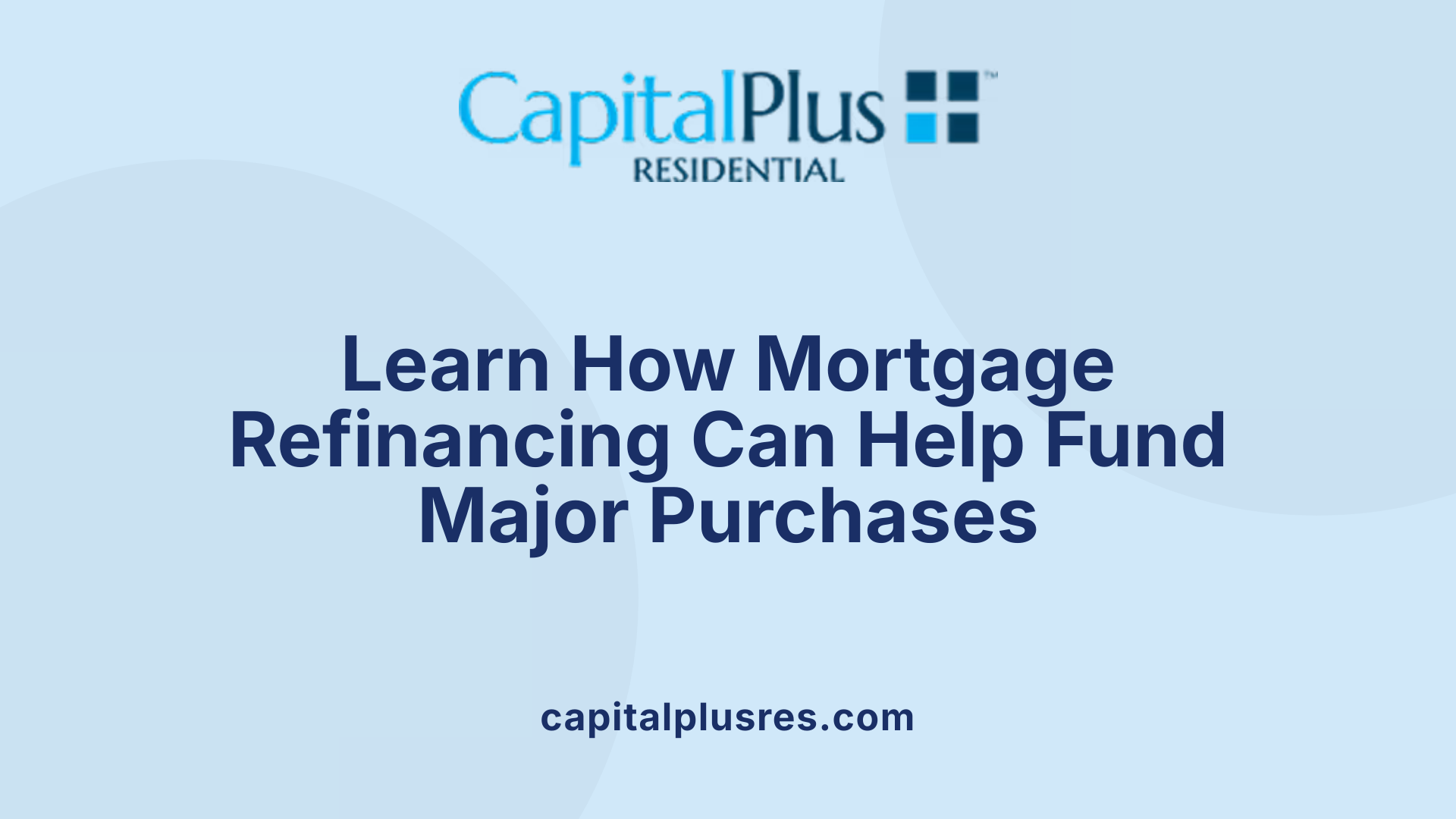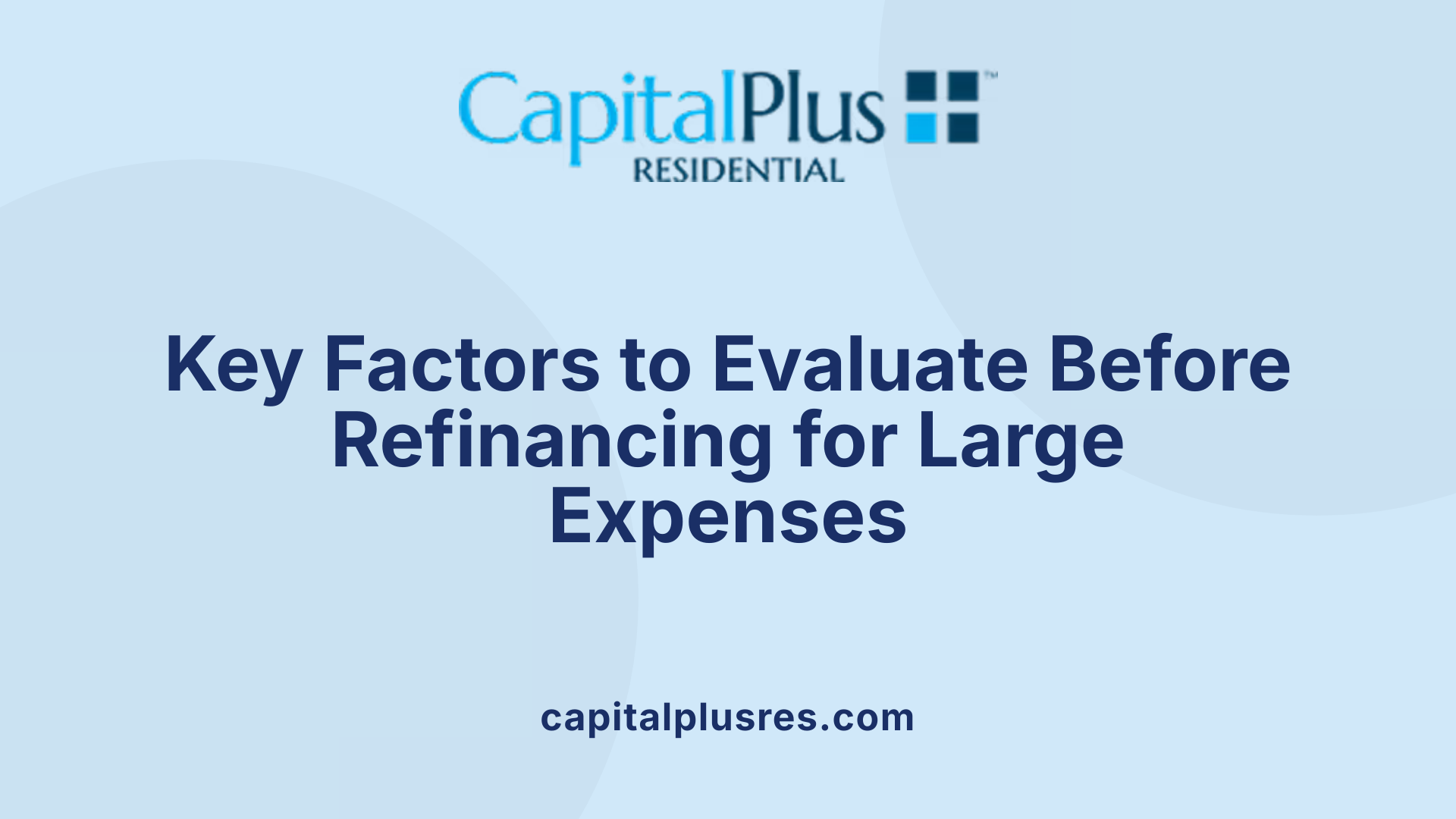Leveraging Mortgage Refinancing for Significant Purchases
Many homeowners seek effective ways to finance large expenses, from home renovations and education to debt consolidation and investment opportunities. Mortgage refinancing emerges as a versatile financial strategy that allows access to a significant pool of funds through tapping into home equity. This guide explores how refinancing works, the various options available, crucial considerations, and how to determine if it’s the right move for funding your major expenditures.
Understanding the Basics of Mortgage Refinancing

How does mortgage refinancing work and can it be used to finance large purchases?
Mortgage refinancing involves replacing your current home loan with a new one. This process can help secure lower interest rates, extend or reduce the loan term, or access your home equity. Typically, the process includes several steps: a credit check, submission of financial documents, a home appraisal, underwriting, and finally, the closing. It usually takes about one to two months to complete.
One popular reason homeowners refinance is to generate cash, especially for large expenditures. This is often done through a cash-out refinance, where you borrow against the equity in your home. Equity refers to the difference between your home's current market value and what you still owe on your mortgage. By tapping into this equity, you can fund major costs such as home improvements, college tuition, or paying off high-interest debt.
However, refinancing isn't free—it involves closing costs like fees for appraisals, title searches, and lender charges. Therefore, it's important to weigh the potential savings or benefits against the costs involved. If interest rates are significantly lower than when you initially took out your mortgage—typically by at least one percentage point—and you plan to stay in your home long enough to recoup the costs, refinancing can be a smart financial move.
In summary, home refinancing not only offers a way to potentially lower monthly payments and interest rates but also serves as a powerful tool to access your home’s equity for large purchases. Carefully considering your financial situation and the purpose of the funds will help determine whether refinancing is the right choice for your needs.
Exploring Different Types of Refinancing Options

What are the different types of refinancing options, such as cash-out refinancing and home equity loans?
When homeowners decide to refinance, they have several options tailored to different financial goals and situations. These options include rate-and-term refinancing, cash-out refinancing, home equity loans, and home equity lines of credit (HELOCs). Each serves a specific purpose and offers unique benefits.
Rate-and-term refinancing is the most straightforward type, where you replace your existing mortgage with a new one that has a different interest rate or loan term. This can help lower monthly payments or reduce the total interest paid over the life of the loan, without increasing the loan amount.
Cash-out refinancing allows homeowners to access their home equity as cash. In this process, the new loan amount exceeds the remaining balance of the current mortgage, and the difference is given to the borrower as a lump sum. This cash can be used for major expenses like home renovations, tuition, or debt repayment.
Home equity loans are lump-sum, fixed-rate loans secured against your home’s equity. They are ideal for large, one-time expenses, providing a set amount of money that is paid back in fixed installments.
Home equity lines of credit (HELOCs) are revolving credit lines based on your home’s equity. They work similarly to credit cards, allowing you to borrow and repay funds repeatedly up to a certain limit, which makes them suitable for ongoing projects or multiple small expenses.
Lastly, streamline refinancing offers a simplified process, often with fewer documents and lower costs, perfect for qualifying government-backed loans such as FHA, VA, or USDA loans. These options may sometimes include no-closing-cost alternatives to minimize upfront expenses.
| Refinance Type | Purpose | Main Features | Typical Use Cases |
|---|---|---|---|
| Rate-and-term | Change interest rate or term | Lower payments or shorten/lengthen loan | Reducing interest cost, adjusting term |
| Cash-out | Access home equity as cash | Larger loan, cash withdrawal | Home improvements, debt payoff |
| Home equity loan | Fixed lump-sum loan | Fixed rate, predictable payments | Major expenses, consolidations |
| HELOC | Revolving credit based on equity | Flexible borrowing, multiple draws | Ongoing expenses, renovations |
| Streamline refinance | Simplified process for government loans | Less documentation, lower costs | Quick refinancing, lower upfront fees |
Homeowners should consider their financial goals, current interest rates, and the amount of equity available before choosing the right refinancing option. Each type offers distinct advantages suited to different needs and circumstances.
Factors to Consider When Refinancing for Large Expenses

What factors like interest rates, fees, and savings should be considered when refinancing for large expenses?
Refinancing to cover large expenses requires careful evaluation of several important factors. First, interest rates play a vital role; securing a lower rate can significantly reduce your monthly payments and the total interest paid over the life of the loan. It’s advisable to compare current market rates and determine if they are lower than your existing mortgage rate.
Next, consider the fees and closing costs involved. These typically range from 2% to 6% of the loan amount and include appraisal fees, lender origination fees, title services, and other expenses. Calculating the break-even point — when your savings offset these upfront costs — helps determine if refinancing is worthwhile.
Home equity is another crucial consideration. Usually, lenders require at least 20% equity in your home to qualify for better refinancing terms and to avoid private mortgage insurance (PMI). To access larger sums for expenses, you may need to opt for a cash-out refinance, which allows borrowing up to 80% of your home’s value.
Your credit score and debt-to-income ratio heavily influence your eligibility and the interest rate offered. A higher credit score typically results in more favorable loan terms, while a lower ratio improves approval chances.
Loan features such as fixed versus adjustable rates and loan duration also matter. Fixed-rate loans provide predictable payments, while adjustable ones might start with lower rates that can fluctuate. The decision depends on your financial stability and market outlook.
Lastly, timing and choosing a reputable lender are essential. Monitoring market interest rates and selecting lenders with competitive rates and reliable service can help maximize your savings. Carefully aligning your refinancing plan with your financial goals ensures you make the most of your home’s equity while managing costs effectively.
Step-by-Step Process of Refinancing for Major Expenditures

What are the steps involved in refinancing a mortgage for large expenditures?
Refinancing your home to cover major expenses involves a series of careful steps designed to ensure you get the best possible loan conditions. First, begin with a thorough financial assessment. Review your current mortgage terms, check your credit score, and evaluate your home equity, which is essential in qualifying for favorable refinancing options.
Next, determine your goals. Are you looking to lower your monthly payments, access cash for a large purchase, or perhaps switch to a different loan type? Clear goals will guide your choices throughout the process.
Upon understanding your financial standing and objectives, gather necessary documentation. These include proof of income, recent bank statements, tax returns, and any existing mortgage statements. This documentation helps lenders accurately evaluate your eligibility.
After preparation, shop around for multiple lenders. Request and compare offers, paying close attention to interest rates, closing costs, and loan terms.
Once you select a preferred lender, the application process continues with the underwriting stage. Here, the lender assesses your financial profile, including debt-to-income ratio and creditworthiness.
Simultaneously, an appraisal of your home is conducted to verify its current market value, ensuring the loan amount aligns with the property’s worth.
If everything meets the lender’s criteria, you will lock in an interest rate. This step secures the rate despite fluctuations in the market during the remaining steps.
The closing process typically occurs within 30 to 45 days after application submission. During closing, you review and sign the final documents, pay any applicable closing costs, and officially refinance the mortgage.
After closing, you'll have access to the funds—either as cash for your expenses or through improved loan terms—that support your large expenditures, from home renovations to debt consolidation.
Best Timing for Refinancing to Support Large Purchases

When is the right time to consider refinancing for large purchases, and what factors influence this decision?
Timing your refinance correctly can significantly impact your financial benefits. The most advantageous moments often occur when interest rates are lower than your current rate by at least 0.75% to 1%. This rate difference helps ensure that the costs of refinancing, including closing fees which typically range from 3% to 6% of the loan amount, are justified by the savings.
Monitoring interest rate trends and the overall economic environment is crucial. Economic conditions such as stable inflation rates, favorable Federal Reserve policies, and declining bond yields usually lead to lower mortgage rates.
Another important aspect is assessing your home equity levels. Generally, lenders require at least 20% equity to qualify for refinancing with better terms. Higher equity can also allow you to access more funds through a cash-out refinance if needed for big expenses.
Your personal financial stability plays a key role. A strong credit score (preferably above 620) and a debt-to-income ratio below 43% are essential for favorable refinancing terms and approval.
Additionally, consider how long you plan to stay in your home. To make refinancing worthwhile, you should plan to remain in the house long enough to recoup the closing costs—usually within five to seven years. If you anticipate moving soon, the upfront costs may outweigh the benefits.
Timing also involves preparing necessary documentation such as proof of income, current mortgage details, and an appraisal. Being well-prepared ensures a smoother process when market conditions become favorable.
In summary, the best time to refinance for large purchases is when interest rates are at historical lows relative to your current rate, your home equity is substantial, your financial position is stable, and you plan to stay in the home long enough to benefit from the new terms. Awareness of these factors and strategic planning can help homeowners maximize their savings and access the funds needed for major expenses.
Major Benefits of Using Refinancing to Fund Large Expenses
What are the benefits of using mortgage refinancing to fund large purchases?
Refinancing your mortgage offers several advantages that can significantly support large expenses. One of the main benefits is the ability to access cash through a cash-out refinance. This process involves borrowing more than the amount owed on your current mortgage, with the difference providing a lump sum of cash. Homeowners often use this to fund major projects such as home renovations, pay for college tuition, or cover other substantial costs.
Lower interest rates are another key advantage. Refinancing often allows you to replace your existing loan with one that has a more favorable rate, resulting in lower monthly payments and decreased total interest paid over the life of the loan. This makes larger expenses more manageable and cost-effective in the long run.
Switching from an adjustable-rate mortgage (ARM) to a fixed-rate mortgage can also enhance financial stability by locking in predictable payments. Additionally, borrowers can choose to shorten their loan term, such as moving from a 30-year to a 15-year mortgage, which speeds up the payoff timeline and reduces overall interest costs.
Refinancing provides flexibility to revise loan terms or consolidate high-interest debt like credit cards, personal loans, or auto loans. This can improve overall financial health and reduce monthly obligations.
However, it's important to consider the costs involved, such as closing fees, which typically range from 3% to 6% of the loan amount. Weighing these costs against the benefits is essential for making informed financial decisions.
In summary, mortgage refinancing can be a strategic tool for funding large expenses, lowering payments, and improving financial flexibility, but should be approached with careful planning.
Using Mortgage Refinancing as a Strategic Financial Tool
How can mortgage refinancing be used as a strategic financial tool for major expenses?
Refinancing a mortgage provides homeowners with flexible options to manage their finances effectively. One of the primary uses is accessing home equity through a cash-out refinance, which allows borrowers to withdraw funds for large expenses like home renovations, college tuition, or financial emergencies.
By replacing an existing mortgage with a new one that offers better terms—such as lower interest rates or varied loan durations—homeowners can reduce their monthly payments or shorten the time needed to pay off the mortgage. This strategic approach can lead to significant savings over the loan's life.
Switching from an adjustable-rate mortgage (ARM) to a fixed-rate mortgage provides payment stability, shielding homeowners from potential interest rate hikes in the future.
Refinance options also include paying off high-interest debt, such as credit cards, personal loans, or auto loans, which can lower overall interest expenses and boost credit scores.
Timing plays a crucial role; leveraging favorable market conditions or increasing home equity can maximize benefits. Homeowners should consider current interest rates, how long they plan to stay in their home, and their long-term financial goals when deciding whether to refinance.
Overall, mortgage refinancing acts as a versatile tool to improve liquidity, manage debt, and ensure more predictable payments, helping homeowners navigate significant financial needs more effectively.
Risks, Costs, and Considerations of Refinancing for Large Purchases
Refinancing a mortgage to fund significant expenses, such as home improvements, education, or debt consolidation, involves various financial considerations and risks that homeowners should thoroughly evaluate.
One of the primary factors is the upfront and ongoing costs. Typically, refinancing costs range from 3% to 6% of the loan amount. These include fees like origination charges, appraisal fees, title services, and credit report fees. While some closing costs can be rolled into the new loan, this increases the total debt owed and the amount of interest paid over time. It’s also important to account for additional expenses such as survey fees or attorney fees, which may add to the overall cost.
Another consideration is interest rate risk. When refinancing, homeowners might opt for a longer repayment period or accept a higher interest rate, which can lead to paying more total interest over the life of the loan. Conversely, locking in a lower rate can be beneficial, but market conditions often fluctuate, and rates may rise after application. Thus, timing the refinance is crucial.
Extending the loan term is a common strategy to lower monthly payments, but this approach can increase total interest paid over the duration of the loan. It also means the homeowner takes longer to fully own the property, potentially delaying financial independence and increasing exposure to market fluctuations.
Market value fluctuations pose another risk. A decline in home values after refinancing could lead to negative equity, especially if the new loan amount exceeds the home's market value. This can complicate future refinancing or selling activities and may affect the homeowner’s financial stability.
Additionally, applying for multiple loans or refinancing can temporarily impact your credit score, making future borrowing more challenging. Careful assessment and planning are essential to avoid unintended credit implications.
Performing a break-even analysis—calculating how long it will take for the savings from refinancing to cover the initial costs—is an effective tool. If the break-even point extends beyond the period you intend to stay in the home, refinancing may not be advantageous.
Altogether, while refinancing can offer substantial benefits such as lower interest rates or access to cash, homeowners must weigh these benefits against the potential risks and costs. A thorough review of their financial situation and market conditions will help ensure that refinancing aligns with their overall financial goals.
Making an Informed Decision on Mortgage Refinancing
Using mortgage refinancing as a funding source for large purchases can be a powerful financial strategy, offering access to significant cash, potential lower interest rates, and flexible loan terms. However, it requires careful consideration of the costs, risks, eligibility criteria, and timing. Thorough analysis, comparing different refinancing options, and consulting with reputable lenders can help ensure this approach aligns with your long-term financial goals. When executed thoughtfully, refinancing can be a valuable tool to meet major financial needs while optimizing your overall financial health.
References
- Mortgage Refinancing: What Is It And How Does It Work?
- Cash-out refinance | How does it work?
- Can You Refinance a Home Equity Loan?
- Home Refinance 101: Understanding the Benefits and ...
- Cash-Out Refi to Buy a Second Home or Investment Property
- Refinancing: What is it and how does it work?
- The Ultimate Guide to Refinancing a Home
- Understanding the costs of refinancing
- 7 Reasons Not to Refinance Your Mortgage
- A Consumer's Guide to Mortgage Refinancings
Latest Blog


Get Pre-Approved Today
Start your secure online application now so you can get pre-approved for a mortgage (and close on your dream home) quickly within 5 minutes.









